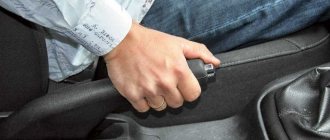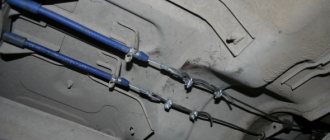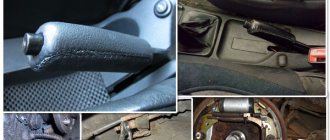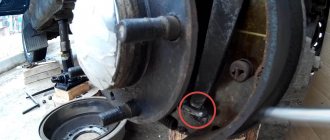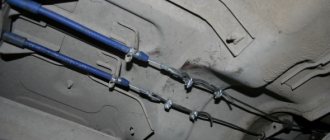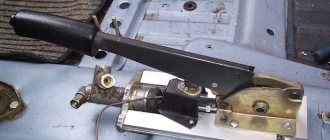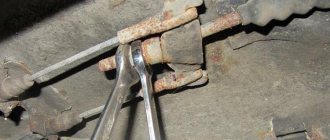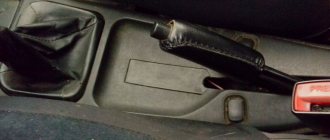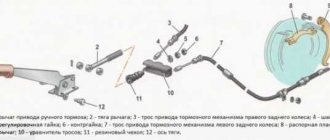The parking brake is a recoil system for fixing a car at stops and parking places, as well as an integral part of the components and assemblies of the car. If you frequently and unreasonably tighten the handbrake lever, problems may arise with the cable, which begins to stretch over time.
This leads to a decrease in the braking efficiency of the vehicle. It is not necessary to visit a service station to troubleshoot the problem. You can tighten or change the part yourself.
Types of hand brake
Depending on the make and model of the car, the parking brake has the following classification according to the type and principle of operation:
- mechanical; Mechanical type parking brake system drive: 1 – lever fixation button; 2 – parking brake drive lever; 3 – protective cover; 4 – traction; 5 – cable equalizer; 6 – adjusting nut; 7 – lock nut; 8 – cable; 9 – cable sheath
- hydraulic;
- electromechanical (aka electronic);
- pneumaticPneumatic hand brakes are installed on heavy trucks. Hydraulic ones are rarely used.
The most common type of handbrake is mechanical. In general, passenger cars are equipped with either a mechanical or electronic parking brake.
Parking brake device
The main element that activates the brakes is the cable. The cable is better when it consists of a large number of thin veins with a diameter of 0.01 mm. These thin steel wires are twisted and twisted into one rope. If the cable consists of one wire, then its reliability is less, since it is a single-core cable that is easy to break. The cable material is high-strength steel.
The diagrams show the design of a mechanical parking brake of the mechanical type.
Mechanical type parking brake system drive: 1 – lever fixation button; 2 – parking brake drive lever; 3 – protective cover; 4 – traction; 5 – cable equalizer; 6 – adjusting nut; 7 – lock nut; 8 – cable; 9 – cable sheath Design of the rear wheel drum brake mechanism: 1 – hub fastening nut; 2 – wheel hub; 3 – lower tension spring of the pads; 4 – brake pad; 5 – guide spring; 6 – wheel cylinder; 7 – upper tension spring; 8 – expansion bar; 9 – finger of the parking brake drive lever; 10 – parking brake drive lever; 11 – brake shield
According to the manufacturing technology, the cables are hardened and lubricated in order to minimize the friction force that occurs in the cable casing.
In the last article, I discussed how to replace brake pads with your own hands. Look.
On the outside, the cable is wrapped in metal wire and covered with a polymer material (rubberized plastic). At the ends, the cable shell has special steel shells and sleeves that are pressed into place.
1 — lever; 2 — button; 3 — thrust spring; 4 — latch rod; 5 — cover; 6 — front cable; 7 — rear cable guide; 8 — spacer sleeve; 9 — tension spring; 10 — spacer bar; 11 — lever for manual drive of brake pads; 12 - rear cable.
Working principle of manual mechanical brake with drum brakes:
- The driver raises the brake handle until a certain click is heard. If the cable is tightened, then perhaps you can only put it on the first latch with more force. If it is too weak, then even at the last latch the brake pads will not secure the wheels 100%.
- The rod pulls the main cable, and it pulls the secondary cables through the mounting bracket.
- The lever that is located inside the brake drum begins to turn and the spacer bar equally moves the pads apart, as a result of which the pad linings are pressed against the drum and do not allow it to rotate.
- When the driver lowers the handbrake, the cables are loosened, the springs in the drums return the spacer and the lever (the one in the drum), the pads are compressed and no longer act with their linings on the drum.
On cars with disc rear brakes, the principle of operation of a mechanical handbrake is approximately the same. The cable pulls a lever, which in turn compresses the brake disc. The lever on disc brakes is mounted behind the hub and on the outside.
Operating principle of the electronic handbrake:
- The truck driver presses the handbrake button, the electronic unit receives the command.
- The controller includes 2 electric motors with gearboxes that are installed on the rear wheels.
- Electric motors compress the brake pads around the disc. The sensor determines how hard to compress the pads. If the brake pads are worn down, the pads compress with greater force.
- To disable the electromechanical handbrake, just press the button.
Pros of an electronic brake:
- If the driver forgot to turn off the parking brake, then after starting the internal combustion engine while starting the car, the controller will release the pads.
- To unlock the rear wheels, the driver will not be able to release the brake by simply pressing. You must first start the engine, buckle up, put your foot on the brake and press the button.
- On vehicles with electric brakes, there is an Auto Hold anti-recoil button. When the car stops with the internal combustion engine running, the wheel locking is automatically activated immediately. This allows drivers to take off on different inclines.
Electronic brakes are more reliable than mechanical ones, although electric brakes have this disadvantage: they will not work with a dead battery. Mechanical brakes are simple in design, but a common cause of failure or reduced effect is cable contamination, stretching or breakage.
Adjusting the parking brake
If the pads are normal, that is, the linings on them are not completely worn out, then adjustment is carried out only by tensioning the handbrake cable. As a rule, the brake cable adjustment is carried out directly in the cabin. The tension bracket is covered with a decorative panel in the area of the handbrake handle. If possible, you need to park the car in an inspection hole or on an overpass and inspect the integrity of all mechanisms of the braking system. If the inspection reveals no problems, such as cable kinks, etc., then we proceed in this order:
- Raise the handbrake handle all the way. This is usually 4-5 clicks of the latch.
- Remove the decorative trim covering the parking brake tension control unit.
- Using a 12 wrench, turn the central nut clockwise - this is the process of tensioning the cable. At the same time, we check the rotation of the rear wheels, whether they rotate with this tension. If the wheel can still be rotated, then turn the nut further.
- Release the brake handle. If the pads do not loosen the wheels, unscrew the nut half a turn.
After adjusting the parking brake, its functionality should be checked on a slope of 10-15 degrees.
When to tighten and when to change?
During operation of the machine, the steel cable gradually stretches and begins to sag. Then part of the lever stroke is used to remove this slack (the first 2-3 clicks), and only then the force is transferred to the brake pads of the rear wheels. As a result, they are weakly pressed against the surface of the discs or drums and the car does not brake reliably.
The first sign of a malfunction is that the handbrake stops working on the first two clicks of the handle and is raised by hand without any effort. In this case, it is definitely necessary to tighten the hand brake, or rather the cable drive.
But the operation of the mechanism also depends on other factors:
Abrasion of the linings does not have much effect on the operation of the main system, since the stroke of the hydraulic pistons is quite large. But the effect of the mechanical “handbrake” gradually weakens. To return it to working condition, it is necessary to compensate for the wear of the elements by tensioning the drive. If the cable itself is in satisfactory condition, the extension of the tension pin will be enough to ensure the operation of the parking brake at any degree of wear on the linings.
The cable is replaced in the following situations:
- The element has stretched to such an extent that at maximum tension the pads do not grip the discs and the car rolls away on any slope.
- Due to the constant ingress of water under the cable casing, it rusted and became tightly jammed. This happens when a motorist rarely uses the handbrake.
Cable jamming also occurs in winter, when water trapped under the casing freezes inside. In this situation, do not rush to change it; first warm up the car in the garage, and then drive out the moisture using WD-40 aerosol lubricant.
How to replace the parking brake
If after adjustment the parking brake does not work, it barely holds, and the cable is tightened to the maximum until it stops, then it’s time to make a replacement.
To replace the main cable or those extending to the wheels, you must also put the car in an inspection hole.
From the interior, remove the decorative trim at the base of the handbrake and unscrew the nut with which the adjustment was made. For auxiliary cables, the equalizers must be disconnected by turning 90 degrees.
Remove the brake drum, brake pads, and use a screwdriver to pull the cable tip out of the groove on the release lever. Using pliers (pliers), we open the spring retainer and remove it from the shield.
Lubricant for hand brake cable
It is better to lubricate the cable with a grease that has good performance characteristics: a high maximum melting point and resistant to oxidation.
Litol 24 cable lubricant is excellent. You can also use its foreign analogues.
Used or flushing oil is not suitable for cable lubrication. Such oils do not have preservative properties and contain sulfur with water, resulting in oxidation.
Video
This video shows how to change the handbrake cable.
Replacing the cable on a Nissan X-Trail car (Nissan X trail).
Adjusting the handbrake of Nissan Qashqai (Nissan Qashqai).
How does a car's parking brake work?
On this page we will consider such a topic as the correct adjustment of the handbrake. There will also be a video on this topic at the end.
While surfing the Internet, I was surprised at how people adjust the handbrake and teach others how to do it. I was even more surprised when I decided to look at what they wrote about in the Murzilkas. As it turned out, a rather strange algorithm for adjusting the handbrake is also described there.
Okay, on YouTube everyone is ripping each other off and pouring the same thing into the masses, only from different cameras and video cameras, but Murzilkas seem to be supposed to be smart books that people pay money for
I always say that you don’t need to listen to information on the Internet, you just need to listen and leave the final decision to your own brains, not to others.
Okay, enough of the rambling, let's go...
